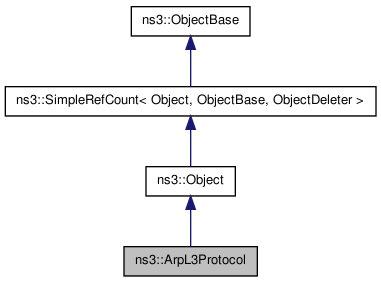An implementation of the ARP protocol. More...
#include <arp-l3-protocol.h>


Public Member Functions | |
| void | SetNode (Ptr< Node > node) |
| Ptr< ArpCache > | CreateCache (Ptr< NetDevice > device, Ptr< Ipv4Interface > interface) |
| void | Receive (Ptr< NetDevice > device, Ptr< const Packet > p, uint16_t protocol, const Address &from, const Address &to, NetDevice::PacketType packetType) |
| Receive a packet. | |
| bool | Lookup (Ptr< Packet > p, Ipv4Address destination, Ptr< NetDevice > device, Ptr< ArpCache > cache, Address *hardwareDestination) |
| Perform an ARP lookup. | |
Static Public Member Functions | |
| static TypeId | GetTypeId (void) |
| This method returns the TypeId associated to ns3::ArpL3Protocol. | |
Static Public Attributes | |
| static const uint16_t | PROT_NUMBER |
Protected Member Functions | |
| virtual void | DoDispose (void) |
| virtual void | NotifyNewAggregate () |
Detailed Description
An implementation of the ARP protocol.
Member Function Documentation
| virtual void ns3::ArpL3Protocol::DoDispose | ( | void | ) | [protected, virtual] |
This method is called by Object::Dispose or by the object's destructor, whichever comes first.
Subclasses are expected to implement their real destruction code in an overriden version of this method and chain up to their parent's implementation once they are done. i.e., for simplicity, the destructor of every subclass should be empty and its content should be moved to the associated DoDispose method.
It is safe to call GetObject from within this method.
Reimplemented from ns3::Object.
| static TypeId ns3::ArpL3Protocol::GetTypeId | ( | void | ) | [static] |
This method returns the TypeId associated to ns3::ArpL3Protocol.
This object is accessible through the following paths with Config::Set and Config::Connect:
- /NodeList/[i]/$ns3::ArpL3Protocol
- /NodeList/[i]/DeviceList/[i]/$ns3::AlohaNoackNetDevice/Phy/$ns3::ArpL3Protocol
- /NodeList/[i]/DeviceList/[i]/$ns3::BaseStationNetDevice/BsIpcsPacketClassifier/$ns3::ArpL3Protocol
- /NodeList/[i]/DeviceList/[i]/$ns3::BaseStationNetDevice/LinkManager/$ns3::ArpL3Protocol
- /NodeList/[i]/DeviceList/[i]/$ns3::BaseStationNetDevice/SSManager/$ns3::ArpL3Protocol
- /NodeList/[i]/DeviceList/[i]/$ns3::BaseStationNetDevice/ServiceFlowManager/$ns3::ArpL3Protocol
- /NodeList/[i]/DeviceList/[i]/$ns3::NonCommunicatingNetDevice/Phy/$ns3::ArpL3Protocol
- /NodeList/[i]/DeviceList/[i]/$ns3::SubscriberStationNetDevice/Classifier/$ns3::ArpL3Protocol
- /NodeList/[i]/DeviceList/[i]/$ns3::SubscriberStationNetDevice/LinkManager/$ns3::ArpL3Protocol
- /NodeList/[i]/DeviceList/[i]/$ns3::SubscriberStationNetDevice/SSScheduler/$ns3::ArpL3Protocol
- /NodeList/[i]/DeviceList/[i]/$ns3::UanNetDevice/Channel/NoiseModel/$ns3::ArpL3Protocol
- /NodeList/[i]/DeviceList/[i]/$ns3::UanNetDevice/Channel/PropagationModel/$ns3::ArpL3Protocol
- /NodeList/[i]/DeviceList/[i]/$ns3::UanNetDevice/Mac/$ns3::ArpL3Protocol
- /NodeList/[i]/DeviceList/[i]/$ns3::UanNetDevice/Phy/$ns3::ArpL3Protocol
- /NodeList/[i]/DeviceList/[i]/$ns3::UanNetDevice/Transducer/$ns3::ArpL3Protocol
- /NodeList/[i]/DeviceList/[i]/$ns3::WimaxNetDevice/$ns3::BaseStationNetDevice/BsIpcsPacketClassifier/$ns3::ArpL3Protocol
- /NodeList/[i]/DeviceList/[i]/$ns3::WimaxNetDevice/$ns3::BaseStationNetDevice/LinkManager/$ns3::ArpL3Protocol
- /NodeList/[i]/DeviceList/[i]/$ns3::WimaxNetDevice/$ns3::BaseStationNetDevice/SSManager/$ns3::ArpL3Protocol
- /NodeList/[i]/DeviceList/[i]/$ns3::WimaxNetDevice/$ns3::BaseStationNetDevice/ServiceFlowManager/$ns3::ArpL3Protocol
- /NodeList/[i]/DeviceList/[i]/$ns3::WimaxNetDevice/$ns3::SubscriberStationNetDevice/Classifier/$ns3::ArpL3Protocol
- /NodeList/[i]/DeviceList/[i]/$ns3::WimaxNetDevice/$ns3::SubscriberStationNetDevice/LinkManager/$ns3::ArpL3Protocol
- /NodeList/[i]/DeviceList/[i]/$ns3::WimaxNetDevice/$ns3::SubscriberStationNetDevice/SSScheduler/$ns3::ArpL3Protocol
- /NodeList/[i]/DeviceList/[i]/$ns3::WimaxNetDevice/BandwidthManager/$ns3::ArpL3Protocol
- /NodeList/[i]/DeviceList/[i]/$ns3::WimaxNetDevice/BurstProfileManager/$ns3::ArpL3Protocol
- /NodeList/[i]/DeviceList/[i]/$ns3::WimaxNetDevice/Channel/$ns3::UanChannel/NoiseModel/$ns3::ArpL3Protocol
- /NodeList/[i]/DeviceList/[i]/$ns3::WimaxNetDevice/Channel/$ns3::UanChannel/PropagationModel/$ns3::ArpL3Protocol
- /NodeList/[i]/DeviceList/[i]/$ns3::WimaxNetDevice/ConnectionManager/$ns3::ArpL3Protocol
- /NodeList/[i]/DeviceList/[i]/$ns3::WimaxNetDevice/Phy/Channel/$ns3::UanChannel/NoiseModel/$ns3::ArpL3Protocol
- /NodeList/[i]/DeviceList/[i]/$ns3::WimaxNetDevice/Phy/Channel/$ns3::UanChannel/PropagationModel/$ns3::ArpL3Protocol
Attributes defined for this type:
-
CacheList: The list of ARP caches
- Set with class: ns3::ObjectVectorValue
- Underlying type: ns3::Ptr< ns3::ArpCache >
- Flags: read
TraceSources defined for this type:
- Drop: Packet dropped because not enough room in pending queue for a specific cache entry.
Reimplemented from ns3::Object.
| bool ns3::ArpL3Protocol::Lookup | ( | Ptr< Packet > | p, | |
| Ipv4Address | destination, | |||
| Ptr< NetDevice > | device, | |||
| Ptr< ArpCache > | cache, | |||
| Address * | hardwareDestination | |||
| ) |
Perform an ARP lookup.
- Parameters:
-
p destination device cache hardwareDestination
- Returns:
| virtual void ns3::ArpL3Protocol::NotifyNewAggregate | ( | ) | [protected, virtual] |
This method is invoked whenever two sets of objects are aggregated together. It is invoked exactly once for each object in both sets. This method can be overriden by subclasses who wish to be notified of aggregation events. These subclasses must chain up to their base class NotifyNewAggregate method. It is safe to call GetObject and AggregateObject from within this method.
Reimplemented from ns3::Object.
The documentation for this class was generated from the following files:
- src/internet-stack/arp-l3-protocol.h
- doc/introspected-doxygen.h
 1.7.1
1.7.1